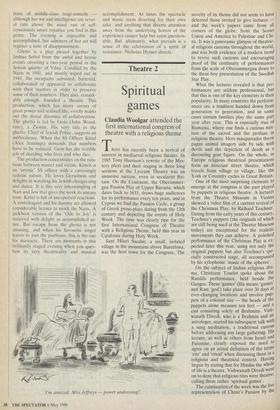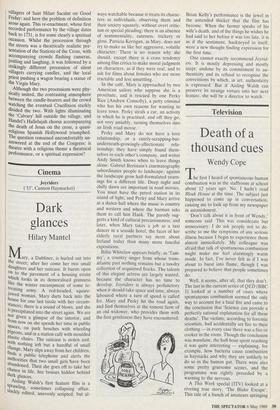Theatre 2
Spiritual games
Claudia Woolgar attended the first international congress of theatre with a religious theme There has recently been a revival of interest in mediaeval religious theatre. In 1985 Tony Harrison's rewrite of the Mys- tery plays and their staging in three long sessions at the Lyceum Theatre was an immense success, even in secularist Bri- tain. On the Continent, the Oberammer- gau Passion Play of Upper Bavaria, which dates back to 1633, draws huge audiences for its performance every ten years, and in Cyprus we find the Passion Cycle, a group of Greek prose-plays dating from the 13th century and depicting the events of Holy Week. The time was clearly ripe for the first International Congress of Theatre with a Religious Theme, held this year in Catalonia during Holy Week.
Sant Hilari Sacalm, a small, isolated village in the mountains above Barcelona, was the host town for the Congress. The
'I'm amazed, Miss Jeffreys — power undressing!'
novelty of its theme did not seem to have deterred those invited to give lectures — and the week's papers came from all corners of the globe: from the Soviet Union and America to Palestine and Chi-
na. It was a panoramic glimpse of theatric- al religious customs throughout the world, and was both evidence of a modern trend
to revive such customs and encouraging proof of the continuity of performances from the scale of Oberammergau down to the three-boy presentation of the Swedish Star Play.
What the lectures revealed is that per- formances are seldom professional, but
that this is one of the key elements in their
popularity. In many countries the perform- ances are a tradition handed down from
generation to generation, and in some cases certain families play the same part year after year. This is especially true of Rumania, where one finds a curious mix-
ture of the sacred and the profane in religious theatre. Here masquerades throw
pagan animal imagery side by side with
devils and the depiction of death as a devouring goat figure. On the whole, in
Europe religious theatrical presentations form an itinerant street theatre, which travels from village to village, like the York or Coventry cycles in Great Britain. One of the most surprising elements to emerge at the congress is the part played by puppets in religious theatre. A lecturer from the Theatre Museum in Vienna showed a video film of a current revival of the Christmas Play, by Richard Teschner.
Dating from the early years of this century, Teschner's puppets (the originals of which are still being used at the Theatre Museum today) are exceptional for the realistic movements they can achieve. A polished
performance of the Christmas Play is ex- pected later this year, using not only the original puppets but also Teschner's spe- cially constructed stage, all accompanied by his xylophonic 'music of the spheres'.
On the subject of Indian religious dra- ma, Christiane Tourlet spoke about the Ramlila performance, held beside the
Ganges. These 'games' (lila means 'games' and Ram 'god') take place Over 30 days at ever-changing locations and involve puP- pets of a colossal size — the heads of the puppets alone measure ten feet — and cast consisting solely of Brahmins. Vish- wanath Divedi, who is a Brahmin and an
astrologer, started his subsequent talk with
a sung meditation, a traditional custom before addressing any large gathering. His, lecture, as well as others from Israel and
Palestine, clearly exposed the need to agree on an actual definition of the terms 'rite' and 'ritual' when discussing these in a
religious and theatrical context. Having begun by stating that for Hindus the whole of life is a theatre, Vishwanath Divedi went on to deny that religious rites were theatre, calling them rather 'spiritual games'. The culmination of the week was the live representation of Christ's Passion by the
villagers of Sant Hilari Sacalm on Good Friday: and here the problem of definition arose again. This re-enactment, whose first recorded performance by the village dates back to 1731, is for some clearly a spiritual occasion. Whilst the procession through the streets was a theatrically realistic pre- sentation of the Stations of the Cross, with accompanying crowds flashing cameras, jostling and laughing, it was followed by a strikingly different procession of silent villagers carrying candles, and the local Priest pushing a wagon bearing a statue of the Virgin Mary.
Although the two processions were phy- sically united, the contrasting atmosphere between the candle-bearers and the crowd watching the eventual Crucifixion starkly divided the two. With lights illuminating the 'Calvary' hill outside the village, and Handel's Hallelujah chorus accompanying the death of Jesus on the cross, a quasi- religious Spanish Hollywood triumphed. The question remained uncomfortably un- answered at the end of the Congress: is theatre with a religious theme a theatrical Performance, or a spiritual expression?



















































 Previous page
Previous page